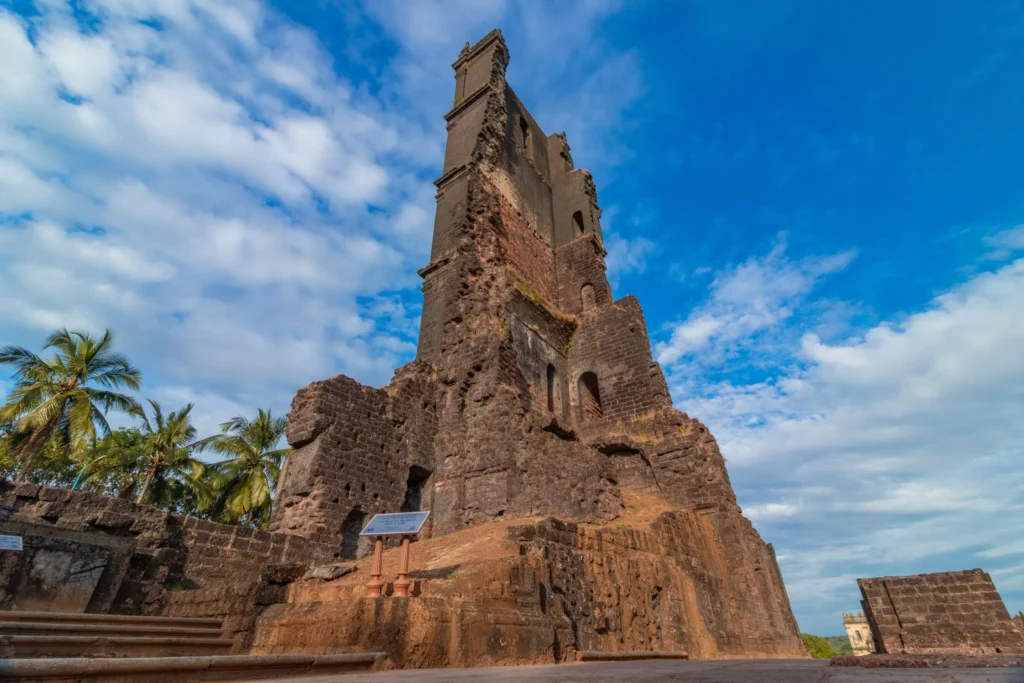
To the west of the Nunnery of Santa Monica, Goa, rises a magnificent octagonal tower. It is the only surviving tower of four that once belonged to the Church of St. Augustine. This was the largest Church in Goa, now a desolate Ruin with its glory days behind. Nevertheless, for those who dig deep enough, this Ruin still does have some secrets to reveal.
History
It had been constructed by the Augustinian order and had incorporated within it. The Church of Our Lady of Grace and the Convent of St. Augustine. The College had been christened the College of Populo, and it also contained within it the Seminary of St. Guilherme. The church bore the title “Our Lady of Grace” and was started in the year 1597, completed circa 1602. At that time, the church was built with four towers and a great vault. Which was equal in size to the great imperial cathedrals built in the Renaissance.
Construction
Of the other tower, one constructed in laterite material, it rises to four storeys. They built it as a belfry, and its ancient bell now swings in the belfry tower of the Church of Our Lady of Immaculate Conception in Panaji. The original church consisted of eight chapels and four altars, with a convent attached to it. On entering they were confronted with a High altar. Before which was a richly-carved retable, supported by soaring pillars, vestiges of whose are visible even today.
The great Vault
The great vault of the church, collapsed in its major part due to its weight, left the entire nave open to the sky. There was also a choir and a choir loft before the High altar. Which was capable of holding a large chorus of monks. The convent, built on three levels, once contained two cloisters, numerous corridors, pillars, and galleries. There were also remains found of a refectory – a dining hall, guest house, and infirmary. It had big dormitories and many cells where the monks lived.
Abandonment and Ruination
In 1835, the Augustinians left the church, and in 1846, the church’s central vault imploded. Which followed in short order by an explosion that left the entire convent in ruins. Today, all that is left of these magnificent shrines is the belfry of the tower. Which would have towered an impressive 150 feet in the air.
Legend and Lore
The story goes that the church’s vault was not easy to build. It collapsed on two separate occasions during its construction. Third time around, the architect placed his only son inside the church and had a cannon fired at the building to demonstrate his faith. Luckily it held.
Archaeological Heritage
Though this is a ruin, the site has still got some archaeological value. The recent discovery of the remains of Queen Ketevan of Georgia is the result of careful studies since 1990. Queen Ketevan was the dowager queen of Kakheti, a kingdom in Georgia. Her husband’s death saw an invasion of her kingdom by Shah Abbas I, who seized her and took her prisoner. It was in 1624 that she decided to die for her faith. Rather than convert to Islam and enter Shah Abbas’ harem.
Two Augustinian monks who befriended her secretly took her remains to Goa. Many people probably lost many relics said to be hers when they abandoned the convent. But archeological work at the site in 2009 uncovered an arm bone and other fragments that year, believed to be hers.
Conclusion
Today, very little is left of the church and monastery that stood with the St. Augustine Church Complex. But, however, it’s not a bad idea to drop by once. One can climb over the old ruins, which itself gives time to ponder over the existence of time and its effects. Thus, this site, though rich in history and hidden secrets, presents a peculiar sight of the glorious past of Goa.


